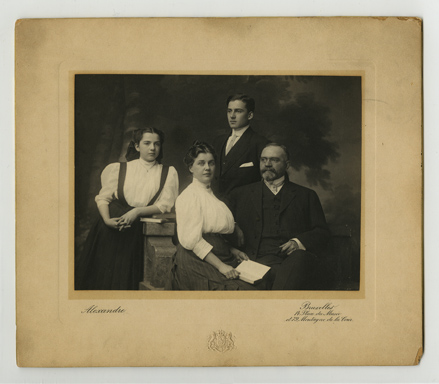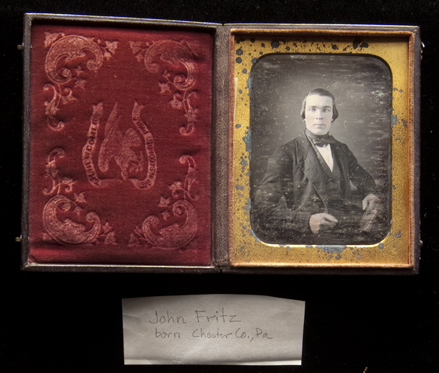Some of the collections here at HSP aren't just useful to genealogists -- they were created by genealogists. One of these is the Batcheler, Hartshorne, and Sahlin families papers (collection 3173), which span several generations and centuries. The collection was curated by Penelope (Penny) Hartshorne Batcheler (1928-2007), a Philadelphia restoration architect who was involved in the restoration of Independence Hall in the 1960s and many other local projects. She inherited great deal of family records from her mother, Ellen Sahlin Hartshorne (1895-1988), who had collected materials from both sides of her Swedish-American family. Both mother and daughter conducted genealogical research, contacting relatives on both sides of the Atlantic and collecting articles, letters, and vital records. These materials, along with notes from Ellen and Penny, make up the "Genealogical research" subseries in this collection.
(Bertil Boëthius and his wife, Gerda Fahlberg Boëthius, 1970.)
This family is remarkable, not only because of how well they preserved their own stories, but also because of their accomplishments. The Swedish side of the family (the Sahlin and Boëthius families) is well documented in Swedish archives. This makes sense because one of its members, Bertil Boëthius (1885-1974), was the riksantikvarie, or national archivist, of Sweden. Gerda Boëthius (1890-1962), Bertil's sister, was an influential art historian, who became director of the Zorn Museum in Mora, Sweden and was a tireless advocate of Swedish folk art and folkways. (She was also, as Ellen's father said in a 1911 letter, "a terrible example of this crazy idea of crowding unclean knowledge into a girls brain.") Their uncle, Axel Boëthius (1889-1969) was a well-known professor of archeology in Sweden before moving to Rome to head the newly founded Swedish Institute of Rome. He was also on friendly terms with the Swedish king.
(Sahlin family portrait, c. 1907. Clockwise from left: Ellen, Robert, Axel, and Gertrude.)
Ellen's father, Axel Sahlin (1855-1937) founded the American branch of the family when he married Gertrude Chandler Sahlin (1860-1953) in 1884. They had two children, Ellen and Robert (Bob), who spent large parts of their childhood in Sweden with Axel's family. The family was separated a lot, with Axel working as an engineer in India, England, and Belgium, and both of the children at school either in Sweden or the United States. Although Axel and Gertrude divorced in 1915, Ellen and Bob both kept in touch with their Swedish relatives and Ellen especially corresponded with them frequently and visited Sweden several times.
(Penelope Hartshorne (with camera) in Sweden, September 1954.)
Ellen's friendship with her Swedish relatives ended up shaping her daughter's career. After receiving her degree in architecture in 1953, Penny moved to Sweden to study Swedish architecture, often working with and learning from Gerda Boëthius. According to this interview [pdf], her drawings of Swedish log cabins were a large part of why she got her job with the National Park Service. This kicked off a long career of preserving Philadelphia's historic buildings, including Independence Hall, Elfreth's Alley (where she met her husband, architect George Batcheler), the Arch Street Friends Meeting House, and the Samuel Powel House.
(John Fritz daguerreotype, c. 1848. With handwritten note from Penelope Batcheler.)
But these are just the major players in this fascinating family. Ellen and Penny carefully collected any family documents they could get their hands on, so this collection contains a lot of surprises. Gertrude Chandler Sahlin was the niece of steel industry pioneer John Fritz (1822-1913), so we have documents about him and some of his belongings that Ellen, Bob, and Penny later donated to Pennsylvania museums. The Chandler family was also, at one point, traced back to Charlemagne -- as is documented in this collection. The Boëthius family includes Maria-Pia Boëthius (granddaughter of Simon Bertil, the archivist), a feminist social and political activist. But the biggest surprise in this collection was the Civil War letters. One folder found with Fritz family research contained letteres from Phineas M. Baker (1838-1865) to his mother Peggy Baker, sister of Mary Meharg Fritz, in which he desribes his time fighting in the war.
(Envelope of a letter from Gertrude Chandler Sahlin to her son, Robert Chandler Sahlin, 1913. Labeled by Penelope Batcheler: "Relations broken with Boethius.")
These resources are all fascinating, but what makes them special to me, as an archivist, is how well they were cared for, preserved, and arranged. This collection was given to HSP by Penny Batcheler with identified, labeled folders, materials grouped together by subject or person, and very little of the disarray we sometimes see in records that have been collected over several generations. She and Ellen even wrote notes about the materials on the materials (in pencil!). Envelopes contain short descriptions of the letters inside, which is especially nice when the letters are in Swedish. Newspaper and magazine clippings are labeled with publication titles, dates, and sometimes the family connection. And Penny herself published typed versions of her grandfather's, Axel Sahlin, and her mother's personal papers and diaries, which contain her own commentary. All of this means that HSP staff can more accurately describe items in the finding aid we make available to researchers, which translates into more searchable keywords, more accurate descriptions, and more efficient research for you, our patrons and guests.






